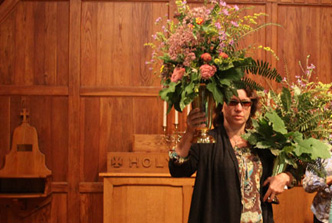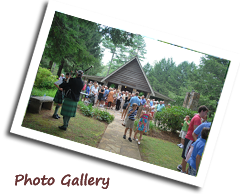 September 1, 1860 – January 19, 1949
September 1, 1860 – January 19, 1949
Alexander Robert Mitchell was born in Charleston, South Carolina on September 1, 1860, a son of Ann Rebecca Magill Mitchell and Alexander Robert Mitchell. His grandfather on his father’s side was an Englishman who had come to Charleston as a youth and had built the first cotton compress. On his maternal side his grandfather, Dr. John Daniel Magill, was one of the large rice planters of the Waccamaw. In prior years the Mitchell family had prospered in the Cotton Compress business and older children had been educated in England. However, young Alex’s father died when Alex was only six years old and the family came upon hard times due to the tragic effects of the War Between the States. Young Alexander attended Porter Military Academy. Following graduation he was in business for a year and then entered the University of the South at Sewanee, Tennessee. At college, he played on the baseball team and was active in the Sigma Alpha Epsilon Fraternity – Tennessee Omega chapter. His chapter was the first in the South to have their own fraternity house, funds for which were raised by the members carrying the mail on the mountain. This feat is portrayed on a large mural in the national headquarters of SAE Fraternity in Evanston, Illinois. Completing his college course, he continued his studies at Sewanee at their Seminary from which he graduated in 1885. In the fall of that year, he was ordained to the Diaconate at Rock Hill, S.C. by Bishop W.B.W. Howe.
His first call was to Columbia, S.C. When he assumed his duties as vicar of the young Church of the Good Shepherd – its cup runneth over. This new young deacon – vibrant with faith and enthusiasm, was full of promise for the parish for the Diocese of S.C. and later, when it was formed, for the Diocese of Upper S.C.
A young man in his twenties, he was tall and slender of build. His eyes under well – shaped brows above high cheekbones sparkled with enthusiasm and yet grew serious with the responsibilities that loomed ahead. Day upon day he would be part of the joys and sorrows of his people. He would hear the prayers of the penitent and rejoice with the glad of heart. He would soothe the growing pains of a young congregation. His sermons would reveal the truths of the gospels. Hymns of his choice would ring out majestic and triumphant. People would appear from beyond the limitations of the parish: the concern of all would be his.
On October 1, 1889, in Trinity Church in Columbia, he was married to Harriet Couturier Thomas, sister of Albert Sidney Thomas, who later became the ninth bishop of S.C. From this union three sons and five daughters were born before Mrs. Mitchell’s untimely death June 20, 1906.
While at the Church of the Good Shepherd, Mr. Mitchell was to build the first of seven churches established during his long ministry of sixty-two years. With the help of his congregation and especially due to the activity of his two brothers-in-law, Albert Sidney Thomas and Harold Thomas, the mission of St. Timothy’s was begun, later to become a full parish.
In fifteen years at the Good Shepherd, Mr. Mitchell was influential in helping the church grow from a weak mission to a vigorous parish – the membership being increased by 500%. In January 1900, Mr. Mitchell accepted a call to be rector of Christ Church, Greenville, S.C. In his sixteen years at Christ Church he built three new missions in Greenville, in addition to leading the church in strong campaigns to involve church members in a more active church life. In the first part of the 20th century, travel was very difficult within the city in bad weather. With this in mind St. Andrew’s Mission was established on Pendleton Street in July 1900. In 1903 the vestry of Christ Church purchased property on Rutherford Street and the first service was help on August 14, 1904 with the new mission being named St. James. The second building is located on Buncombe Street on property donated by Miss Elisa Powell. The present St. James (3rd building) is located on Piney Mountain.
Due to the tireless efforts of the Ladies’ Guild of Christ Church, a memorial window to Bishop Ellison Capers, a former rector and the original founder of Faith Chapel, replaced the original triplet windows in the church in 1914. The window, one of the most beautiful creations of the Mayer Studio of Munich, portrays Christ at the Last Supper, and has become one of the most admired features of Christ Church. The window is believed to be the last shipment to leave Germany before the outbreak of World War I. In 1954 St. James Church observed its 50th anniversary by placing twelve stained glass windows in their church donated by church families in honor of loved ones. These windows were ordered from the same German company and the head of Christ is identical with the window installed forty years earlier at Christ Church.
On December 28, 1910, Mr. Mitchell married Miss Mary Mazyck Lucas of the Wedge Plantation. This union was blessed with four sons. The second son died in infancy.
In 1916 Mr. Mitchell resigned as rector of Christ Church to become Archdeacon of the Diocese of S.C., at that time composed of the entire state. His work centered mostly in the coastal region, where he was to build his fifth church, St. Luke’s at Andrews, S.C. Due to a short period of ill health he resigned in 1921 as Archdeacon to return to Greenville to take charge of the three churches he had built while rector of Christ Church, St. James, St. Andrews and the Church of the Good Shepherd in Greer.
In September 1930 Bishop Albert Thomas preaching on Dr. Mitchell’s 45th anniversary in the ministry summed up his record by saying, “I feel that it is only necessary to quote the words on the tomb of Sir Christopher Wren at St. Paul’s London SI MONUMENTUM QUAERIS, CIRSUMSPICE – if you seek a monument for him, look around you at his work.” These churches and parishes are but the outward visible sign of that pouring out of his heart’s blood for the spiritual and eternal welfare of all his people here. Dr. Mitchell was this kind of man. A few years before his death, a parishioner was raising a purse to give him on the occasion of one of his anniversaries. “Let’s not make it too big” one potential donor said to the amazement of the other man. He then explained, “He (Dr. Mitchell) won’t spend it on himself, and if we make it too big, he’ll be off starting another church.” The State Magazine August 28, 1955.
In 1933 Mr. Mitchell’s alma mater conferred on him the honorary degree of Doctor of Divinity. The University of the South had hoped to have President Franklin Roosevelt speak at commencement and confer on him an honorary degree, but circumstances prevented the president from coming and Postmaster General James Farley arrived in his stead to receive a degree along with Dr. Mitchell.
During the 1920’s and 1930’s the tree churches under Dr. Mitchell continued to grow, but the Great Depression of the 30’s slowed development. The salaries of ministers became very meager and their families often wondered what the future would bring. In the bleakest hours Dr. Mitchell would exclaim ” The Lord will provide” and He always did. By the time Dr. Mitchell was in his seventies and his sons tried to relieve him of driving a car. A typical Sunday was always packed with activity for these sons: Sunday School at 10:00 a.m., St. James at 11:00 a.m., a drive to the Good Shepherd in Greer at 3 p.m., return to Greenville for the meeting of the Young Peoples Service League at 6 p.m., and finally church at St. Andrews at 8 p.m.
Nevertheless the congregations were wonderful and something unexpected was always happening. One lady sat in the rear of the church each Sunday and if Dr. Mitchell’s sermon was too long she rapped on the floor with her umbrella at the spot she thought would be a good ending and exclaimed, “That’s enough, that’s enough.” Fortunately or unfortunately, Dr. Mitchell could not hear her. The rear third of the church could. And then once during the Bishop’s annual visitation when in his sermon on Christian activity he stated that he did not like a certain hymn – “Make me and mold me after thy will, while I am waiting yielding and still,” the organist promptly played it during the offertory, much to the amazement of the rector.
In 1936 Dr. Mitchell had realized that there was no place of worship for members of his flock and other congregations who spent their summers at Caesars Head and Cedar Mountain, resort communities where families from North Carolina, South Carolina, and Florida have summer homes. He called together some of these vacationers for a service originally on the porch of Mrs. Louise H. Cary’s home, later at the home of Dr. Theodore C. Stone in 1937 after Mrs.Cary’s home had been destroyed by fire. The actual chapel was built in 1938 and the first service was conducted by Dr. Mitchell on July 10,1938. The chapel was erected on property donated by Dr. Stone, patriarch of the Stone clan, in behalf of himself, his brothers and sisters, “To the Glory of God and in loving memory” of their father and mother. Since all denominations contributed to the erection of the present building, the chapel maintains a policy of inviting various denominations.
Dr. Mitchell was very ecumenical and had as close friends of that era: Dr. Charles H. Nabers of the First Presbyterian Church, Dr. Leon Latimer of First Baptist Church, Dr. B. Rhett Turnipseed of Buncombe Street United Methodist Church, and Rev. C.T. Squires of the Fourth Presbyterian Church, all in Greenville, S.C. All contributed their services to the Chapel through the years. The Rt. Rev. Monsignor Andrew K. Gwynn, Priest at St. Mary’s Catholic Church, expressed his friendship by home visitations during the last illness of his Episcopal friend.
In early October 1944 Dr. and Mrs. Mitchell were informed by the Army that their son First Lieutenant Robert Mazyck Mitchell of the 82nd Airborne Division, who had been cited for gallantry during the invasion of France in June and July 1944, had been killed leading his company against German fortifications in Holland on September 19, 1944. Although deeply saddened and crushed Dr. Mitchell was in the pulpit the next Sunday proclaiming the love and mercy of God. Friends of the family later retold this to the other two sons in the service at that time in the Army in the China-Burma-India area and in the Navy in the South Pacific.
Dr. Mitchell completed 62 years in the active ministry. He was succeeded by the Rev. John Adams Pinckney (later the fourth Bishop of Upper South Carolina) whom Dr. Mitchell introduced to the congregation as “a man of God, who was born in Charleston,” evidently two most important attributes according to Dr. Mitchell.
After a full life devoted to the service of God and his fellowmen, Dr. Mitchell died January 19, 1949. He left the finest heritage a man could leave to his children, for in the years after his death him children were frequently told, “Your father was a good man.”
Stephen D. Mitchell
Appreciation is given for quotations from the following:
History of the Good Shepherd – Columbia, S.C.
History of Christ Church – Greenville, S.C.

